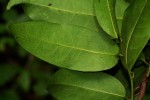Artabotrys monteiroae
Selected images: Click on each image to see a larger version and details of the record View all images (13)
Detailed records: Display species records QDS maps by: Google Maps Point records by Google Maps
Species details: Click on each item to see an explanation of that item (Note: opens a new window)
| Synonyms: |
Artabotrys nitidus Engl. |
| Common names: | Red hook-berry (English) |
| Frequency: | |
| Status: | Native |
| Description: |
Scrambling shrub, small tree or liane. Branches dark reddish-brown to blackish; persistent flower stalks modified into woody curled hooks to aid climbing. Leaves alternate, oblong-elliptic to ovate, up to 14 × 6 cm, leathery, dark- or bluish-green, glossy and hairless above, dull green with hairs along the midrib beneath, net-veining more distinct beneath, apex more or less pointed; margin entire. Flowers 1-9 together, deep yellow to cream or greenish, c. 1 cm in diameter. Fruit in a cluster of ellipsoid or cylindric carpels, up to 1.5 cm long, hairless, glossy red when ripe. |
| Type location: |
Tanzania |
| Notes: | This species is very similar to Artabotrys brachypetalus and is mainly distinguished by the more pointed leaves, more distinct net-veining below, persistent flowering bracts, smaller flowers and glossy red fruits. |
| Derivation of specific name: | monteiroae: after Mrs Rose Monteiro, wife of Portuguese naturalist Joachim Monteiro, who collected plants in Angola and Mozambique. |
| Habitat: | Riverine fringes and evergreen forest, sometimes in woodland and thickets, often among rocks or on termite mounds. |
| Altitude range: (metres) | Up to 2250 m |
| Flowering time: | Oct - Jan |
| Worldwide distribution: | Angola, DR Congo, Burundi, Rwanda, Uganda, Tanzania, Malawi, Mozambique, Zambia, Zimbabwe, Mpumalanga and KwaZulu-Natal, South Africa. |
| FZ divisions: | N,C,S |
| Growth form(s): | Climber, tree, liane, shrub over 2 m. |
| Endemic status: | |
| Red data list status: | |
| Insects associated with this species: | Graphium antheus (Food plant) Graphium morania (Larval foodplant) Graphium colonna (Larval foodplant) Graphium policenes laurentia (Larval foodplant) Graphium porthaon porthaon (Larval foodplant) |
| Spot characters: | Display spot characters for this species |
| Images last updated: | Friday 21 June 2019 |
| Literature: |
Burrows, J.E. & Willis, C.K. (eds) (2005). Plants of the Nyika Plateau Southern African Botanical Diversity Network Report No. 31 SABONET, Pretoria Page 59. (Includes a picture). Burrows, J.E., Burrows, S.M., Lötter, M.C. & Schmidt, E. (2018). Trees and Shrubs Mozambique Publishing Print Matters (Pty), Cape Town. Page 119. (Includes a picture). Chapano, C. & Mamuto, M. (2003). Plants of the Chimanimani District National Herbarium and Botanic Garden, Zimbabwe Page 7. Coates Palgrave, K. (revised and updated by Meg Coates Palgrave) (2002). Trees of Southern Africa 3rd edition. Struik, South Africa Page 210. Da Silva, M.C., Izidine, S. & Amude, A.B. (2004). A preliminary checklist of the vascular plants of Mozambique. Southern African Botanical Diversity Network Report No. 30 Sabonet, Pretoria Page 23. Dowsett-Lemaire, F. (1989). The flora and phytogeography of the evergreen forests of Malawi. I: Afromontane and mid-altitude forests; Bull. Jard. Bot. Nat. Belg. 59(1/2) Page 23. Drummond, R.B. (1975). A list of trees, shrubs and woody climbers indigenous or naturalised in Rhodesia. Kirkia 10(1) Page 237. Golding, J.S. (ed.) (2002). Zimbabwe Plant Red Data List. Southern African Plant Red Data Lists. SABONET 14 Page 171. Mapaura, A. & Timberlake, J. (eds) (2004). A checklist of Zimbabwean vascular plants Southern African Botanical Diversity Network Report No. 33 Sabonet, Pretoria and Harare Page 17. Ntore, S. & al. (2024). Checklist of the vascular plants of Burundi Page 49. Robson, N.K.B. (1960). Annonaceae Flora Zambesiaca 1(1) Pages 131 - 133. (Includes a picture). Siebert, S. & Mössmer, M. (Editors) (2002). SABONET Southern Mozambique Expedition 2001; Provisional Plant Checklist of the Maputo Elephant Reserve (MER) and Licuati Forest Reserve (LFR) SABONET News 7(1) Page 23. Strugnell, A.M. (2006). A Checklist of the Spermatophytes of Mount Mulanje, Malawi Scripta Botanica Belgica 34 National Botanic Garden of Belgium Page 39. Troupin, G. (1978). Annonaceae Flore du Rwanda Spermatophytes Volume I Pages 257 - 258. (Includes a picture). Wursten, B., Timberlake, J. & Darbyshire, I. (2017). The Chimanimani Mountains: an updated checklist. Kirkia 19(1) Page 87. |
Other sources of information about Artabotrys monteiroae:
Our websites:
Flora of Burundi: Artabotrys monteiroaeFlora of the DRC: Artabotrys monteiroae
Flora of Mozambique: Artabotrys monteiroae
Flora of Rwanda: Artabotrys monteiroae
Flora of Zambia: Artabotrys monteiroae
Flora of Zimbabwe: Artabotrys monteiroae
External websites:
African Plants: A Photo Guide (Senckenberg): Artabotrys monteiroaeAfrican Plant Database: Artabotrys monteiroae
BHL (Biodiversity Heritage Library): Artabotrys monteiroae
EOL (Encyclopedia of Life): Artabotrys monteiroae
GBIF (Global Biodiversity Information Facility): Artabotrys monteiroae
Google: Web - Images - Scholar
iNaturalist: Artabotrys monteiroae
IPNI (International Plant Names Index): Artabotrys monteiroae
JSTOR Plant Science: Artabotrys monteiroae
Mansfeld World Database of Agricultural and Horticultural Crops: Artabotrys monteiroae
Plants of the World Online: Artabotrys monteiroae
Tropicos: Artabotrys monteiroae
Wikipedia: Artabotrys monteiroae





